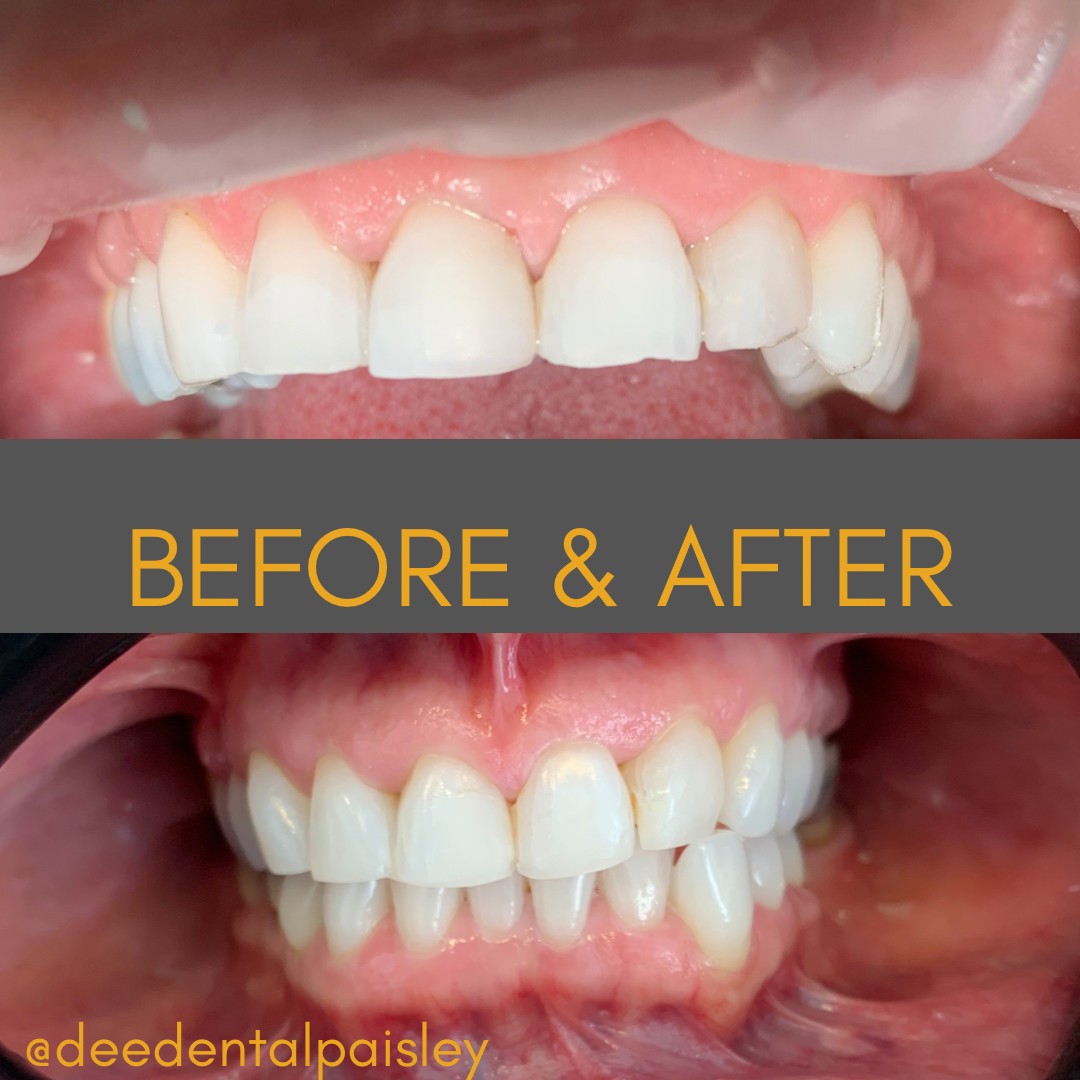Dental Restorations & Restorative Dental Care
Are you dealing with issues such as missing, broken, or weak teeth?
At Dee Dental Paisley, we understand the impact these problems can have on your confidence and oral health. Our restorative dental treatments are designed to provide effective, long-lasting solutions that restore both function and aesthetics to your smile.
Our restorative dentistry focuses on repairing and replacing damaged or missing teeth. Whether you need a single tooth repaired or multiple teeth replaced, we use advanced techniques to make sure that your restorations are strong, durable, and natural-looking.
We offer a comprehensive range of restorative treatments, including fillings, implants, dentures, crowns and bridges. Each treatment is tailored to meet your unique needs to ensure the best possible outcome for your smile and dental health.
Don't let dental issues hold you back. Book a consultation with us to discover how our restorative dental services can transform your smile or chat to us directly on WhatsApp to have any of your questions answered!

What is restorative dentistry?
Restorative dentistry is done to diagnose, prevent, and treat oral diseases to restore the function and integrity of the teeth. It involves procedures that aim to repair damaged teeth, replace missing teeth, and improve overall oral health.
Treatments such as fillings, crowns, bridges, implants, and dentures are common in restorative dental treatments.
The primary goal of restorative dentistry is to ensure that patients can eat, speak, and smile without discomfort. By addressing issues like tooth decay, fractures, and tooth loss, restorative treatments will enhance oral function while contributing to overall well-being.
What is the difference between cosmetic and restorative dentistry?
While both procedures aim to improve the appearance of your smile, their primary focuses are different. Restorative dentistry focuses on the health, function, and structure of the teeth and gums. Treatments in this field aim to restore normal function and prevent further oral health issues.
On the other hand, cosmetic dentistry focuses on improving the appearance of the teeth and smile. Treatments such as teeth whitening, veneers, and composite bonding are designed to enhance the visual appeal of your smile. While these procedures can also have restorative benefits, their main purpose is to create a more attractive smile.
At Dee Dental Paisley, we offer both restorative and cosmetic dentistry services to make sure that our patients receive comprehensive care based on their individual needs. If you need a functional restoration or a cosmetic enhancement, our skilled team is here to help you achieve a healthy, beautiful smile!

What are the different types of Dental Restorations?
- Fillings – Fillings are one of the most popular types of dental restorations. Before, the majority of fillings were made with gold and silver amalgam. Now, composite fillings are widely used as they can mimic your natural tooth colour and fill the cavity seamlessly without standing out.
- Implants – Dental implants are a permanent solution for missing teeth. The procedure involves a titanium screw fusing directly with a bone socket, providing a life-like tooth root. After this metal anchor is fitted and healed, a cap in the form of a crown will be fitted on top to create a natural-looking, sturdy replacement tooth.
- Crowns – Crowns are tooth-shaped caps that fit over a damaged tooth to restore its shape in a natural-looking way. Crowns help add strength to your bite and can be used to hold a bridge in place or fit over a dental implant.
- Bridges – Bridges are designed to literally “bridge” the gap between missing teeth. They are false teeth that can be cemented permanently in place. You also have the option to anchor it by crowns on either side. Common materials used for creating bridges are porcelain, gold or alloys, and sometimes a combination of all.
- Dentures – Dentures are the most well-known form of dental restoration. Unlike the treatments above, dentures are removable and can be replaced. It can come complete or partial, depending on the number of missing teeth a patient may have. Dentures are often made of acrylic resin, combined with metal attachments added for extra sturdiness.
As a trusted restorative dentist in Glasgow, Dee Dental proudly offers all restorative dental treatments mentioned above. If you're unsure of the best treatment for your needs feel free to message us directly on WhatsApp and we'll respond to you promptly.

.jpeg)
What are the advantages of restorative dentistry?
Restorative dentistry has many significant advantages to your oral health and overall wellbeing.
Here are the benefits you can experience:
- Dramatically improve the appearance of your smile. If you have missing or broken teeth, it’s understandable that you might feel conscious when you smile. By undergoing restorative dental treatment, you'll transform your smile and boost your self-confidence and mental health.
- Help strengthen your bite. You will be able to chew much better and easier after having a missing tooth replaced, allowing you to enjoy all kinds of foods that might have been impossible beforehand.
- Can help you speak clearly. Having one or several missing teeth can impact the way you speak. By having these replaced properly, you will regain your usual way of speaking before any dental trauma occurred. Again, this helps to improve a person's confidence as there's no need to feel any level of self-consciousness when expressing yourself.

Why choose Dee Dental for professional restorative dentistry in Glasgow
At Dee Dental, we are dedicated to providing exceptional dental care to our patients.
Consider us for your dental restoration needs:
- Friendly and accommodating environment
Our clinic is designed to make you feel comfortable from the moment you walk in. Our friendly staff are always ready to assist you to ensure a pleasant and stress-free experience. We prioritise creating a welcoming atmosphere where you can feel at ease during your visit.
- Personalised communication
To make it easier for you to reach us, we offer direct communication via WhatsApp. Whether you have questions about your treatment, need to schedule an appointment, or require post-treatment support, our team is just a message away.
- Dental comfort at its finest
We understand that dental treatments may cause you anxiety. At Dee Dental, we are committed to your dental comfort to make sure your experience with us is as calm and comfortable as possible. We make sure to listen to your concerns and tailor our treatments to meet your specific requirements.
- Use of Digital Dentistry
Our use of digital dentistry allows for more accurate diagnostics, precise treatments, and improved outcomes. From digital impressions to computer-guided implant placement, we utilise state-of-the-art technology to enhance your dental experience.
- Access to our expert implantologist
At Dee Dental Paisley, you benefit from the expertise of our highly skilled implantologist, Dr. Sam Elassar. Dr. Elassar has been on his implant journey since 2007, placing over 3,000 implants to date. He is an ex-ADI Regional Representative for Scotland, dedicated to improving public understanding of the benefits of implantology.
- Team of professional dentists
We boast our team of highly-skilled dentists who undergo rigorous training to guarantee superior results for our patients. They are well-equipped with the latest techniques and advancements in dental technology to provide you quality service and patient satisfaction.
- Use of composite fillings
Our clinic uses composite resin in every dental restoration we do, so we can mimic the natural look of your teeth and provide you with a durable option that can last for years. We do not use amalgam or mercury fillings as these have been proven to cause issues for both your dental health and aesthetic appearance.

Restorative Dental Care: Frequently Asked Questions
Who is restorative dentistry for?
Generally speaking, the treatment is suited to anyone with missing teeth or parts of their teeth. It can also be used to treat those suffering from decay, fracturing or tooth weakness. Restorative dentistry doesn't only improve the look of the tooth. It also restores its function.
What are the risks of dental restoration work?
Thanks to dental advancements over the years, restorative dental treatment is extremely safe and comes with minimal risk to the patient. You can expect some general discomfort and heightened sensitivity around the area of your mouth where treatment was carried out. However, this should subside after a week or so.
What type of filling is best?
The two main options patients face when it comes to fillings are between amalgam fillings and composite fillings.
With its aesthetic and long-lasting benefits, we recommend choosing composite filling.
Composite fillings are made from plastic resin, allowing them to seamlessly mimic the natural shade of your teeth. They are also more advanced and stronger. Moreover, composite fillings protect more of the tooth structure as there is no need to drill away large parts of the tooth enamel. .
Amalgam silver fillings on the other hand can have a negative impact on your tooth structure, causing more loss of tooth in the future. Despite their popularity in years gone by, there are now serious safety concerns linked to amalgam fillings, largely due to their use of mercury. Mercury can cause harm to your mouth and your overall health and pose a significant risk if the mercury were to leak out of the filling.
At Dee Dental, we always prioritise the safety and comfort of our patients. We only use composite resin in all our dental restoration treatments to ensure the highest levels of safety. The use of composite fillings also allows us to achieve the best possible results for our clients
What aftercare is needed for dental restorations?
As with most procedures, a basic level of aftercare is needed to ensure that your dental restorations stay healthy for a long time.
- Practice good oral hygiene, just as you would with our natural teeth.
- Brush at least twice daily with an electric toothbrush, spending 30 sections on each quadrant of your mouth.
- Floss daily after brushing your teeth.
- Visit your dentist for regular check-ups.
- Contact your dentist immediately if any restoration work comes loose or is damaged.
- Avoid smoking and drinking alcohol.
- Avoid hard or crunchy foods in the weeks after your restorative dental work.
Is restorative dentistry worth it?
Absolutely! Investing in restorative dental treatments can significantly improve both your oral health and quality of life.
It can enhance your oral function, make your smile brighter, prevent further damage, and provide long-lasting results.
Reach out to our friendly team today and get the dental care you need so you can smile with confidence once again!



 - Copy internal.jpg)
%20(2).png)